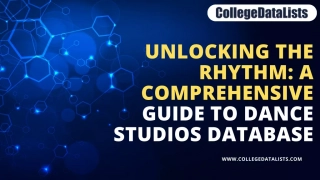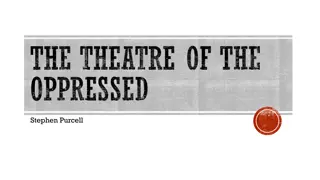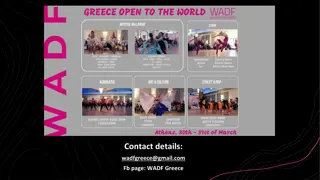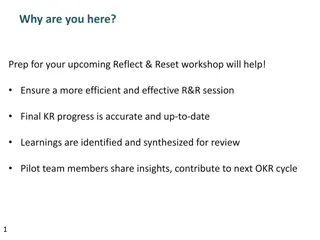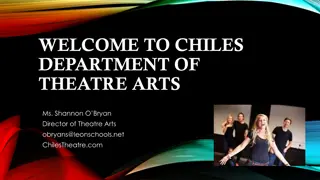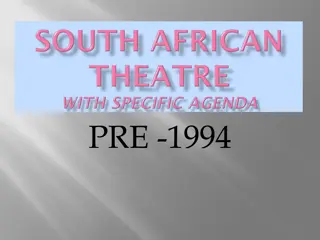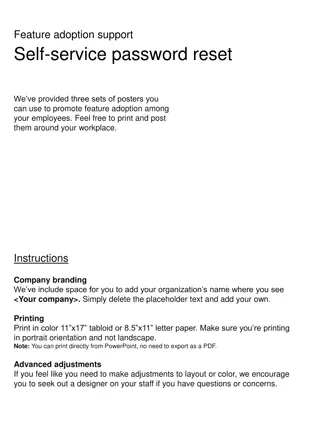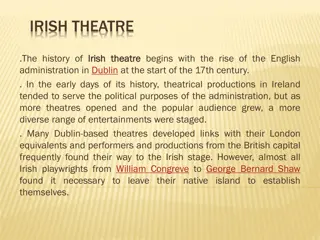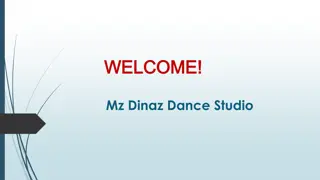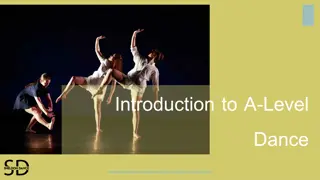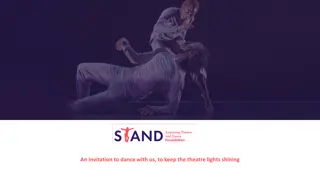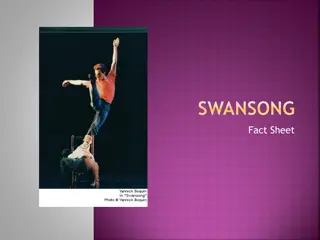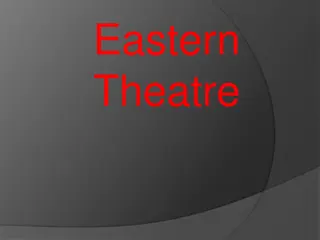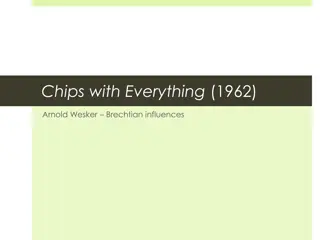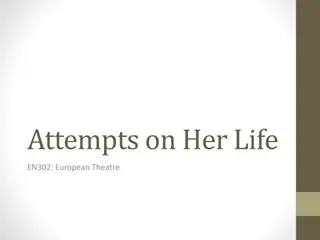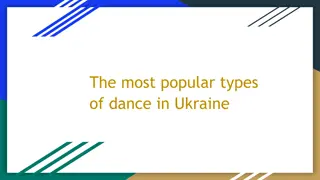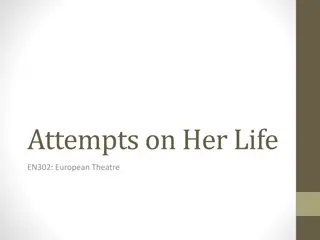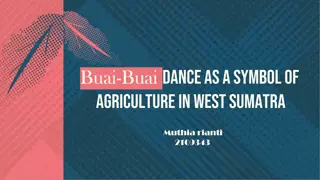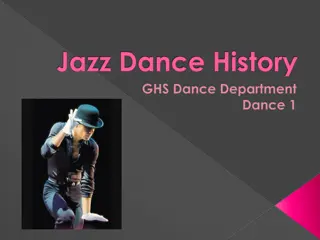Creative Economic Reset: Enhancing Opportunities for Theatre and Dance Practitioners
The discourse explores leveraging digital technology by creative entrepreneurs, addressing challenges in funding and skills development, and predicting the impact of virtual reality on content creation. It emphasizes the need for a versatile repertoire aligned with market demands and the importance of financial literacy for artists to thrive in the evolving landscape.
Download Presentation

Please find below an Image/Link to download the presentation.
The content on the website is provided AS IS for your information and personal use only. It may not be sold, licensed, or shared on other websites without obtaining consent from the author.If you encounter any issues during the download, it is possible that the publisher has removed the file from their server.
You are allowed to download the files provided on this website for personal or commercial use, subject to the condition that they are used lawfully. All files are the property of their respective owners.
The content on the website is provided AS IS for your information and personal use only. It may not be sold, licensed, or shared on other websites without obtaining consent from the author.
E N D
Presentation Transcript
South African Cultural Observatory (SACO) 4th International Conference Creative Economic Reset: Structuring the creative and cultural industries for a sustainable and inclusive future 9-10 November 2022 CSIR International Convention Centre
Reimagining Work: Towards fit for purpose artists in the theatre and dance space Gcinibandla Mtukela Mandela Bay Theatre Complex (MBTC) (An agency of the Department of Sports, Arts and Culture) Nelson Mandela Bay
STRUCTURE OF THE PRESENTATION Introduction Literature Review Thematic segmentation and discussion of findings Conclusion
Introduction Covid_19 and the advent of the Fourth Industrial Revolution have shaken longstanding traditions on what is regarded as work and the circumstances under which work should be undertaken. Successful creative entrepreneurs are those who are fluent at leveraging digital technology to enhance their creative ventures and to widen their scale of influence by broadening their accessibility and reach through technology (Kolisi and Ncwadi, SACO International Conference: 2018) There is a need to address the challenges of lack of equitable access to funding, skills and capacity development and lack of collaborative approaches of theatre and dance practitioners if theatre and dance practitioners are to be provided with an opportunity for growth prospects. (National Socio Economic Impact Assessment System (SEIAS), Revised 2020 of the Department of Arts and Culture) In their discussion on the advent of and impact of virtual reality (as an aspect of High technology and Creative Economies) and its likely impact on the creation of content, Lutshaba and Haines (Culture and Creative Industry Trends) predict that virtual reality will reshape the way people consume content and provide creative industries with a further opportunity to get it right in making content creation more profitable . Economies which stand a better opportunity for growth provide the fundamentals needed to enable the Creative Economy to prosper (Florida: 2002, quoted in Kolisi and Ncwadi, SACO International Conference: 2018).
Versatile repertoire for varying market needs Productions have different needs. What is required from a production for Germans may not necessarily be the same with what is needed by a production for Italians. Artists need to understand what they can offer and also study what is required by the market so that their repertoire can be aligned to the broadest market landscape. Artists also need financial literacy and acumen as well as some level of administrative efficiency. Artists have to dig from their repertoire to cater for the varying needs of the market.
Versatility continued.. Artists need to tap into opportunities within institutions of higher learning. For example institutions of higher learning occasionally need the services of theatre practitioners or drama students to lecture second year students that are doing education in methodologies of story- telling because ultimately when you teach you are telling stories and you need to find a creative way to promote better understanding by students. Whilst a teacher may have good grasp of the subject matter he may not necessarily be your best story teller. There are also Drama Societies, Music Societies etc and students in these Societies may not necessarily have field or industry experts.
Versatility continued further.. Theatre practitioners can gravitate to academia in baby steps. For example, some universities have Drama Societies, Music Societies etc and students in these Societies may not necessarily have field or industry experts. This is additional income for artists as well as strategic leverage which can open further doors as they branch into related opportunities where creativity is required.
Networking, collaborations and relationship-building When it comes to them transcending from being artists to being economically viable, artists need to broaden their circle. Artists cannot hang around with artists. They need to surround themselves with people who understand business operations, who understand the issue of tourists. They need to network with people from disciplines like administration and business backgrounds.
Networking, collaboration etc continued A theatre practitioner should be able to work with artists from other disciplines to broaden one s audiences. For example, if you are a theatre practitioner it would be wonderful to partner with a jazz practitioner because what this means is that you now grow traction across broader audiences since you bring have the platform to attract your jazz audience to your theatre space whilst simultaneously pulling your theatre audience to the jazz stage.
Networking,collaboration etc continued The benefits of getting many people to work with you cannot be overemphasized. An artist with a winning concept should not limit herself to work with one institution or one funding body. S/he has a golden opportunity to get theatres, festivals and funding bodies to work together. You as an artist are attractive. Your work is attractive to all those partners. Collaborations and cross discipline are important.
Networking, collaboration etc continued.. When it comes to them transcending from being artists to being economically viable, artists need to broaden their circle. Artists cannot hang around with artists. They need to surround themselves with people who understand business operations, who understand the issue of tourists. They certainly need financial literacy and acumen as well as a level of administrative efficiency.
Networking, collaboration etc continued.. The last issue is back to basics and back to community support. As an artist, I need to ask myself how do I expect to be supported by South Africa and my region if I am not supported by those within my immediate neighbourhood. Artists need to root themselves within their own neighbourhood communities because this support which comes free can be leveraged as ready audiences and product marketers at a later stage as the artist begins to be noticed and as s/he gathers fame.
Understanding of domestic and global arts and tourism ecosystems Theatre and Dance practitioners need to cultivate an understanding of the full ecosystem of arts and tourism both for domestic and international audiences.
Competence, quality focus and Brand Awareness Artists should never underestimate the importance of focusing on producing quality work at all material times. This should define you as an artist if you are to make an impact. Admittedly, this is in the domain of the subjective but artists must be deliberate about consistently producing a unique experience even if it appears elusive.
Competence, quality focus and Brand Awareness continued.. Theatre and dance practitioners need to learn about the space they play in. For instance if you position yourself as an international artist then you must learn to be agile and consciously cast yourself as one who is capable of adapting your work to the unique message requirements of the audience or country for which you are pitching. The point is that as an artist you need to be deliberate about how you cast or brand yourself through your work. You need to answer the question who are you doing your work for ?
Understanding of the ecosystem within the craft and tourism sector Theatre and dance practitioners need to familiarize themselves with the tourism dynamic so that they do not put together products that may not necessarily be viable for markets where they are headed or destined. This will enable them to pitch for their target audiences in a relevant and aligned manner.
Understanding of the ecosystem etc. continued From the above it is evident that artists need to cultivate an understanding of the full ecosystem of arts and tourism both for domestic and international audiences.
Funding environment Government s funding needs to be structured in a way that it differentiates between emerging and established artists. At this point this doesn t happen. Government funding may not always be adequate to meet the needs of the artists. One strategy that needs to be explored in this regard is to match government funding with corporate funding. This requires deliberate efforts to mobilise corporate funding and to promote co-operation within the entire funding ecosystem to maximize support for artists.
Funding environment continued Theatre and dance practitioners, like other artists, need to open up paths to the private sector. For this to work out, artists need to be able to produce the repertoire of work that can meet the expectations of the corporate. This need may be different to the expectations of a festival, for instance.
Conclusion This paper is an an attempt to contribute to the call for further research into the content of the detail of the skills deficit of the practitioners in the dance and theatre space as instructed by the Strategic Plan and Implementation, September 2022 of the Department of Sports, Arts and Culture. The analysis of findings which is extracted from the practitioner interviewees within the space points to a need for theatre and dance practitioners to equip themselves with a range of competencies, skills and attributes which are essential for effective and profitable participation in the Creative Economy. These skills include business acumen, collaboration and networking, digital and technological literacy as well as the capacity to work inter-disciplinarily and intra-disciplinarily.


